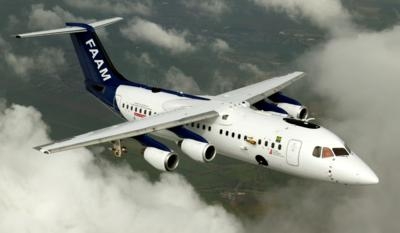Mission Goal Is To Improve Climate Predictions
A BAE Systems research aircraft is about to help scientists measure cloud properties in the Arctic in a bid to improve Arctic climate predictions. The BAe 146 Atmospheric Research Aircraft (ARA) is owned by BAE Systems and was converted by BAE Systems Regional Aircraft into one of the foremost atmospheric research aircraft in the world. This specialized scientific aircraft is a vital tool in the study of weather patterns, climate change and global warming, flying some 500 science hours a year, the highest of any atmospheric research aircraft in the world.

For its latest campaign, the BAe 146 ARA departed Monday from its home base at Cranfield, Bedfordshire, for a three-week tour of duty based at Kiruna in northern Sweden. From there, for its scientific research sorties, it will fly the 2.5 hour leg to Longyearbyen Airport on the Norwegian island of Svalbard which is within the Arctic Circle and the northernmost airport in the world that receives scheduled airline services. After refuelling, the BAe 146 ARA will fly its missions from Svalbard before returning again for more fuel and then heading back to Kiruna. A combined total of 70 hours of scientific, test and transit flying is planned.
This latest campaign called ACCACIA (Aerosol Cloud-Coupling and Climate Interactions in the Arctic), consists of a team of scientists led by the University of Leeds and in collaboration with the University of Manchester, the University of York, the University of East Anglia, the British Antarctic Survey and the UK Met Office. The ACCACIA campaign is part of the National Environment Research Council’s Arctic Research Programme which advances the UK’s research capability in the Arctic, enabling better interpretation of current climate change science, and what the implications are for policymakers and Arctic communities.
For this campaign, BAE Systems had over 30 engineers at Prestwick working to design, approve and certificate seven modifications that were required by the scientists to meet the campaign requirements. These included the introduction of a new wing pylon canister instrument for the detection of cloud droplets ranging from 2-75 micron by laser-initiated light scattering principles. Also, an existing wing-pylon canister instrument was modified to allow it to better operate in Arctic conditions and improvements were carried out to the aircraft Data Logging System.
The aim of the ACCACIA campaign is to reduce the current large uncertainty in the representation of the Arctic climate, the main aspect being the poor understanding and representation of cloud and aerosol processes in climate models in general and in the Arctic in particular. By focusing on measuring cloud microphysical and boundary layer processes that directly affect the surface of the earth and the sources of aerosol (sea-spray and particles derived from the oxidisation of DMS – a gas emitted by marine plankton) that control cloud microphysical properties, the campaign will quantity the feedbacks between clouds, aerosol, sea ice and the wider Arctic climate system to provide a sound foundation for making improved predictions of future Arctic climate.
Funding for this campaign has been provided by the UK Met Office, the Natural Environment Research Council (NERC) and the National Centre for Atmospheric Science (NCAS). During the campaign the BAe 146 ARA will fly above, in, and below cloud taking measurements of cloud microphysical properties and dropping dropsondes over the open ocean, the ice edge, the marginal ice zone and solid ice. It will work alongside and co-ordinate its measurements with a British Antarctic Survey Twin Otter research aircraft which will be used mainly for low-level runs to measure near surface fluxes, and the RV Lance icebreaker research ship, used by the Norwegian Polar Institute, that will operate in the area to the south and west of Svalbard to provide measurements of aerosol sources and aerosol precursor gases at the sea-surface.
The BAe 146 ARA is operated by Directflight in the UK under subcontract to BAE Systems while the Facility for Airborne Atmospheric Measurements (FAAM) manages the scientific tasking on behalf of NERC and the Met Office.
NERC and the Met Office task the aircraft largely on the basis of bids made by Universities or specialist departments of the Met Office, and arrange the necessary funding. FAAM implements the program, arranging with BAE Systems Regional Aircraft the installation of new or different scientific equipment as demanded by each mission.
(Image provided by the Facility for Airborne Atmospheric Measurements [FAAM])
 ANN's Daily Aero-Linx (04.15.24)
ANN's Daily Aero-Linx (04.15.24) Classic Aero-TV: 'No Other Options' -- The Israeli Air Force's Danny Shapira
Classic Aero-TV: 'No Other Options' -- The Israeli Air Force's Danny Shapira Aero-News: Quote of the Day (04.15.24)
Aero-News: Quote of the Day (04.15.24) Airborne 04.16.24: RV Update, Affordable Flying Expo, Diamond Lil
Airborne 04.16.24: RV Update, Affordable Flying Expo, Diamond Lil ANN's Daily Aero-Term (04.16.24): Chart Supplement US
ANN's Daily Aero-Term (04.16.24): Chart Supplement US



